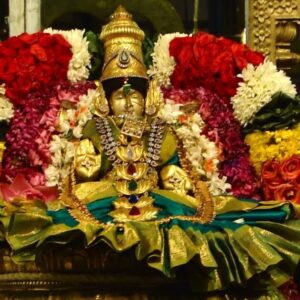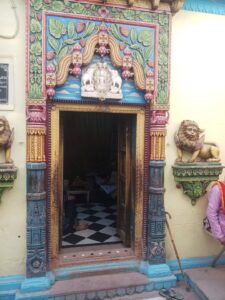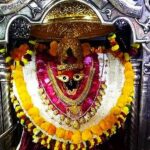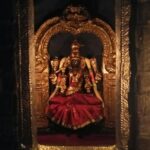VISHALAKSHI TEMPLE,VARANASI,UTTAR PRADESH
Temple History
The Vishalakshi Temple or Vishalakshi Gauri Temple is a Hindu temple dedicated to the goddess Vishalakshi Maa (means wide eyed Devi) at Mir Ghat on the banks of the Ganges at Varanasi in Uttar Pradesh, India. It is generally regarded as a Shakti Pitha, the most sacred temples dedicated to the Hindu Divine Mother. The karna kundala (earring) of the goddess Sati are said to have fallen on this holy spot of Varanasi. Goddess worshiped here as Maa Vishalakshi & Lord Shiva as Kala or Kaal Bhairva.
The Vishalakshi Temple have elaborate gopuram (ornamented tower) which rests above the main entrance. Upon closer inspection, one finds lions flanking a door above which is a lovely marble relief depicting the popular goddess, Lakshmi. Here she sits upon a lotus with elephants on opposite sides pouring water over her, forming a composite glyph that represents abundance. This popular representation of the goddess is known as Gajalakshmi.
The inner periphery of the temple is essentially a concrete wall that has an area which protrudes like a shelf displaying an assortment of Shiva lingams (some with an accompanying Nandi–Shiva’s bull), nagas (divine serpents), and a beautiful Ganesh sculpture. Directly behind the main shrine and opposite the door is a marble statue of Adi Shankaracharya, the famous philosopher monk, seated cross-legged.
On the right side of the temple is an adjacent room which functions like a sacred storage area. It contains two gated areas which respectively house a sculpted horse and an alternative image of the goddess Vishalakshi. These are periodically brought out during special festival processions when Ma Vishalakshi, seated upon the horse, is wheeled about for a small tour of the nearby streets. Also within this room is a smaller shrine dedicated to Shiva and housing a large lingam–the abstract representation of male creative energy, or the sacred phallus. One very interesting feature of this room is an altar upon which rests nine statues depicting the planetary deities from Vedic Astrology in anthropomorphic form: Surya (Sun), Chandra (Moon), Mangala (Mars), Budha (Mercury), Brihaspati (Jupiter), Shukra (Venus), Shani (Saturn), Rahu (Ascending/North lunar node) and Ketu (Descending/South lunar node). These representations are the focus of regular adoration in the form of flower and leaf offerings as well as being marked with bright vermilion powder.
The most ornamented area inside the temple is the verandah directly in front of the main shrine. Its four concrete pillars have been painted over so much that they feel completely smooth when touched. They bare the sculpted reliefs of floral designs, yantras, and protective figures. The ceiling directly above, designed to produce a canopy-like effect, is painted with a grid of 12 squares each containing a different image from a zodiacal house. Above the main shrine we find a scene that would be immediately recognizable to people from Tamil Nadu: a high-relief depiction of Shiva and Meenakshi’s wedding. Meenakshi (the “Fish Eyed”) herself is a popular South Indian goddess and is here associated with Vishalakshi along with Kamakshi (the “Desire Eyed”), to form a triad of goddesses.
Finally we come to the main shrine and Vishalakshi’s seat proper. The sanctum sanctorum (garbhagriha in Sanskrit) contains a very ornate marble shrine which itself contains an even smaller shrine housing the image. This “nesting” of shrines produces a stacked, “Russian doll” type of effect. The original, very ancient murti and its accompanying shrine were placed in the larger shrine and temple as the current structure was quite literally built up around it.
The goddess Vishalakshi herself is represented by a lovely murti carved from a solid piece of polished black stone. Her upraised right arm bears a lotus in its hand, while the palm of her left, downturned hand is empty and facing away. She gazes directly forward and her darshan can easily be obtained from the street when the front doors are open and it is not too crowded inside the temple.
But this stone sculpture, delightful as it is, is not the original representation of Vishalakshi. It was, in fact, carved from stone in 1971 when the temple was renovated with Tamil patronage.
The daughter of Prajapati Daksha, Sati was married to the god Shiva against his wishes. Daksha organized a great yajna, but did not invite Sati and Shiva. Uninvited, Sati reached the yajna-site, where Daksha ignored Sati and vilified Shiva. Unable to withstand this insult, Sati jumped into the sacrificial fire and committed suicide. Sati died, but her corpse did not burn. Shiva (as Virabhadra) slew Daksha for being responsible for Sati’s death and forgave him, resurrecting him. The wild, grief-stricken Shiva wandered the universe with Sati’s corpse. Finally, the god Vishnu dismembered the body of Sati into 51 parts, each of which became a Shakti Pitha, temple to a form of the Goddess. Shiva is also worshipped at each Shakti Pitha in the form of Bhairava, the male counterpart or guardian of the presiding goddess of the Pitha. Sati’s eye or earring is believed to have fallen at Varanasi, establishing Vishalakshi as a Shakti Pitha. However, if one asks at the temple there today, the priest and all others aver that the body part that fell was Her face, which is hidden behind the murti.
In the sacred geography of Varanasi, six points are said to symbolize Shastanga (six-fold) yoga, which is performing by visiting the six sites. They are the Vishwanath Temple (the most important temple of Varanasi – dedicated to Shiva), the Vishalakshi Temple, the Ganges, the Kala Bhairava temple (dedicated to Varanasi’s guardian deity and Vishalakshi’s Bhiarava), the Dhundiraj Temple (dedicated to the god Ganesha – son of Shiva and Parvati) and the Dandapani temple (dedicated to an aspect of Shiva).





